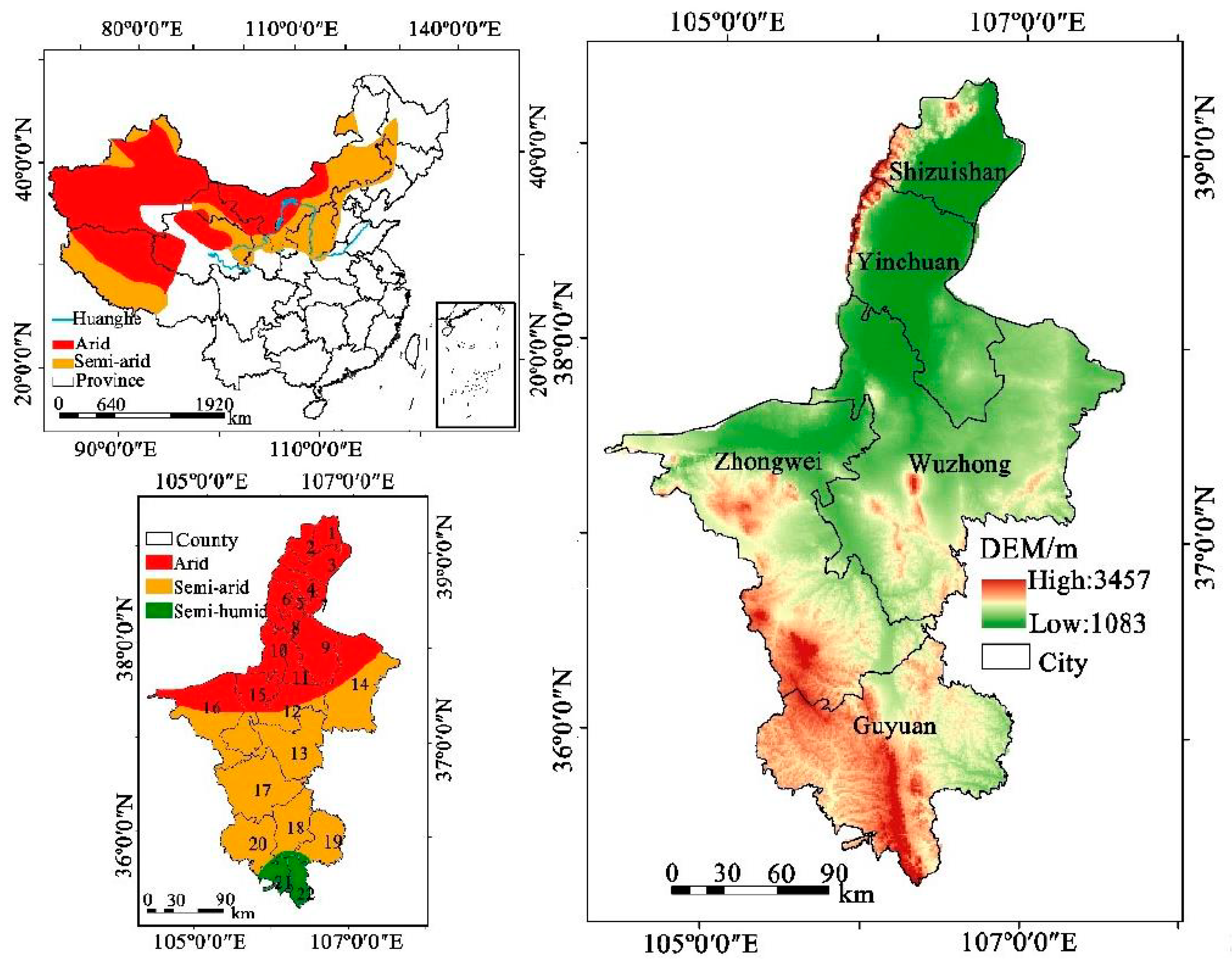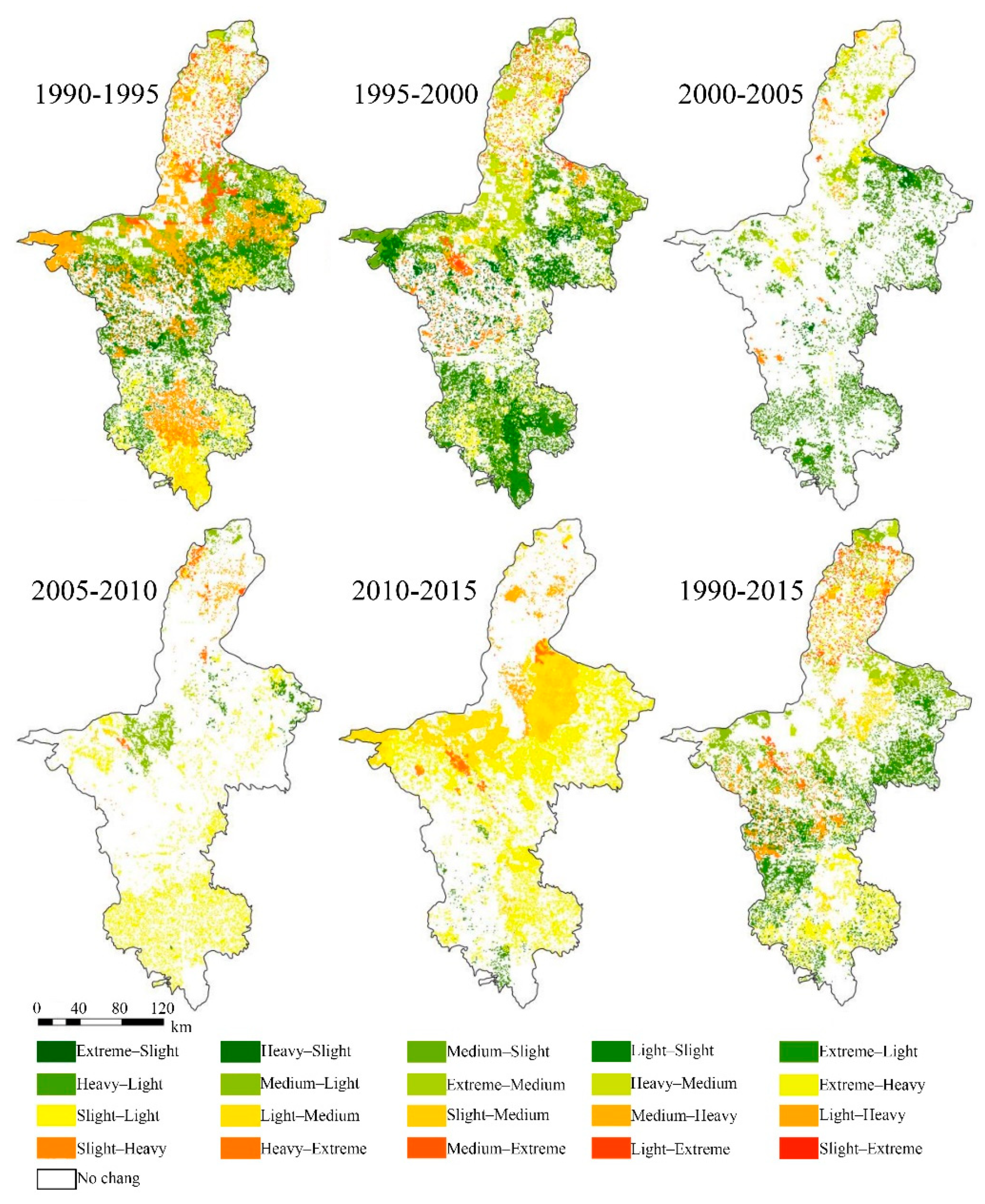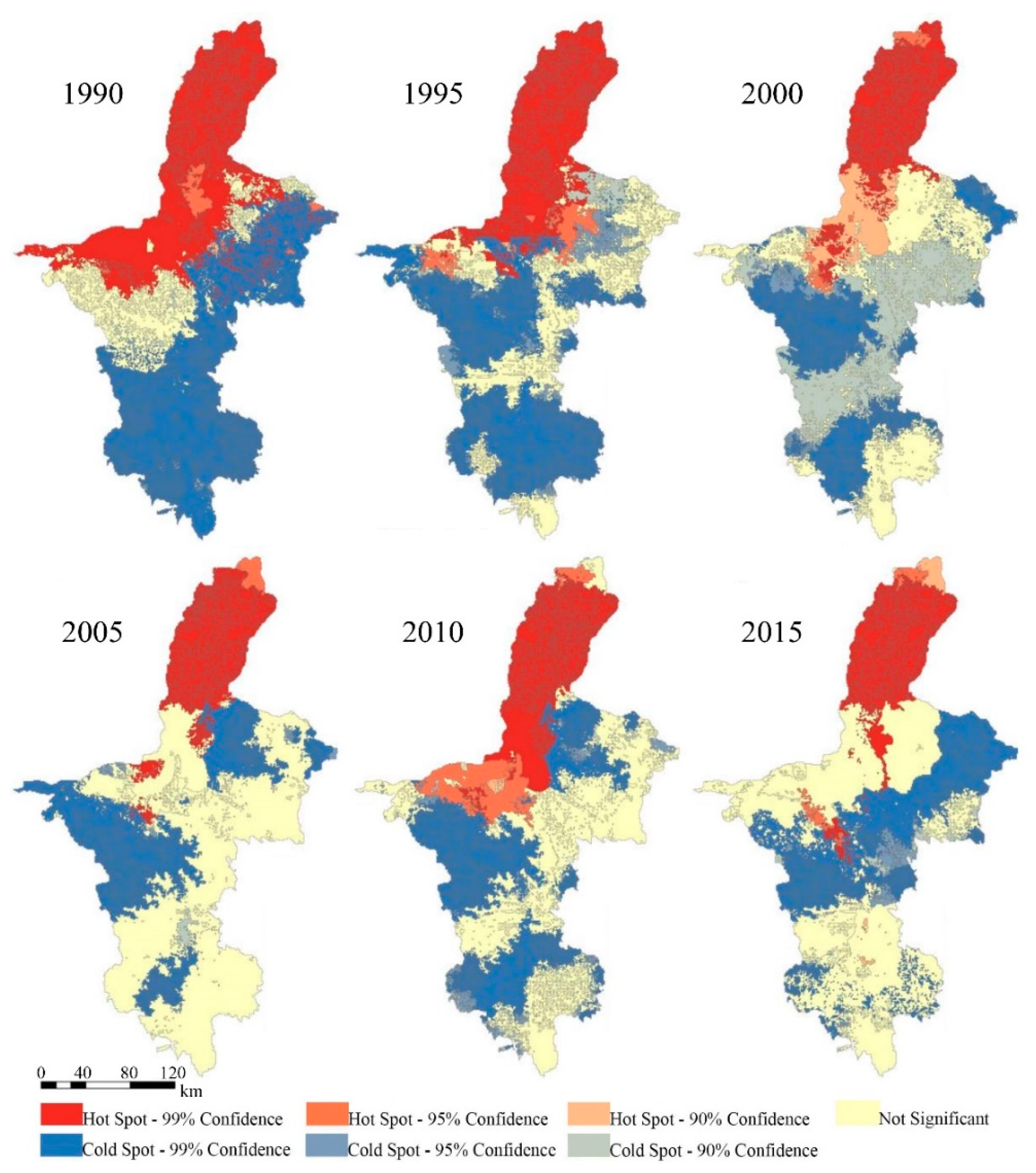Spatial Heterogeneous of Ecological Vulnerability in Arid and Semi-Arid Area: A Case of the Ningxia Hui Autonomous Region, China
Abstract
:1. Introduction
2. Materials and Methods
2.1. Study Area
2.2. Data Collection
2.3. Methods
2.3.1. Assessment of Ecological Vulnerability
2.3.2. Gradient Classification of Ecological Vulnerability
2.3.3. Geo-Information Tupu Change Analysis
2.3.4. Cold‒Hotspot Study Change Analysis
3. Results
3.1. Spatial and Temporal Characteristics of Ecological Vulnerability
- +;
- +;
- +;
- +;
- +;
- +;
3.2. Transformation of Ecological Vulnerability
3.3. Cold‒Hotspot Analysis of EVI
3.4. Driving Factors Analysis
4. Discussion
4.1. Spatial‒Temporal Characteristics of Ecological Vulnerability
4.2. The Impact of Ecological Projects on Ecological Vulnerability
4.3. Suggestions
5. Conclusions
Author Contributions
Funding
Acknowledgments
Conflicts of Interest
References
- Hou, K.; Li, X.; Zhang, J. GIS Analysis of Changes in Ecological Vulnerability Using a SPCA Model in the Loess Plateau of Northern Shaanxi, China. Int. J. Environ. Res. Public Health 2015, 12, 4292–4305. [Google Scholar] [CrossRef] [PubMed] [Green Version]
- Kang, H.; Tao, W.; Chang, Y.; Zhang, Y.; Xuxiang, L.; Chen, P. A feasible method for the division of ecological vulnerability and its driving forces in Southern Shaanxi. J. Clean. Prod. 2018, 205, 619–628. [Google Scholar] [CrossRef]
- De Lange, H.J.; Sala, S.; Vighi, M.; Faber, J.H. Ecological vulnerability in risk assessment da review and perspectives. Sci. Total Environ. 2010, 408, 3871–3879. [Google Scholar] [CrossRef] [PubMed]
- Hou, K.; Li, X.; Wang, J.; Zhang, J. Evaluating Ecological Vulnerability Using the GIS and Analytic Hierarchy Process (AHP) Method in Yan’an, China. Pol. J. Environ. Stud. 2016, 25, 599–605. [Google Scholar] [CrossRef]
- Xiaodan, W.; Xianghao, Z.; Pan, G. A GIS-based decision support system for regional eco-security assessment and its application on the Tibetan Plateau. J. Environ. Manag. 2010, 91, 1981–1990. [Google Scholar] [CrossRef] [PubMed]
- Cutter, S.L.; Boruff, B.J.; Shirley, W.L. Social vulnerability to environmental hazards. Soc. Sci. Q. 2003, 84, 242–261. [Google Scholar] [CrossRef]
- Mi, Z.; Wei, Y.M.; Wang, B.; Meng, J.; Liu, Z.; Shan, Y.; Liu, J.; Guan, D. Socio-economic impact assessment of China’s CO2 emissions peak prior to 2030. J. Clean. Prod. 2017, 142, 2227–2236. [Google Scholar] [CrossRef] [Green Version]
- Songa, G.; Chena, Y.; Tianb, M.; Lvb, S.H.; Zhanga, S.H.; Liua, S. The ecological vulnerability evaluation in southwestern mountain region of China based on GIS and AHP method. Procedia Environ. Sci. 2010, 2, 465–475. [Google Scholar] [CrossRef] [Green Version]
- Ren, X.; Dong, Z.; Hu, G.; Zhang, D.; Li, Q. A GIS-Based Assessment of Vulnerability to Aeolian Desertification in the Source Areas of the Yangtze and Yellow Rivers. Remote. Sens. 2016, 8, 626. [Google Scholar] [CrossRef] [Green Version]
- Abson, D.J.; Dougill, A.J.; Stringer, L.C. Using principal component analysis for information-rich socio-ecological vulnerability mapping in Southern Africa. Appl. Geogr. 2012, 35, 515–524. [Google Scholar] [CrossRef]
- Inostroza, L.; Palme, M.; de la Barrera, F. A Heat Vulnerability Index: Spatial Patterns of Exposure, Sensitivity and Adaptive Capacity for Santiago de Chile. PLoS ONE 2016, 11, e0162464. [Google Scholar] [CrossRef] [PubMed] [Green Version]
- Li, L.; Jiang, K.Y.; Liu, F.P.; Dou, J.X. Fuzzy comprehensive evaluation and application for vulnerability of complex geological disaster in southwest mountainous area in China. Electron. J. Geotech. Eng. 2014, 19, 6929–6937. [Google Scholar]
- Zhao, J.; Ji, G.; Tian, Y.; Chen, Y.; Wang, Z. Environmental vulnerability assessment for mainland China based on entropy method. Ecol. Indicat. 2018, 91, 410–422. [Google Scholar] [CrossRef]
- He, G.; Bao, K.; Wang, W.; Zhu, Y.; Li, S.; Jin, L. Assessment of ecological vulnerability of resource-based cities based on entropy-set pair analysis. Environ. Technol. 2019, 1–11. [Google Scholar] [CrossRef]
- Takane, S. Effect of domain selection for compact representation of spatial variation of head-related transfer function in all directions based on Spatial Principal Components Analysis. Appl. Acoust. 2016, 101, 64–77. [Google Scholar] [CrossRef]
- Xue, L.; Wang, J.; Zhang, L.; Wei, G.; Zhu, B. Spatiotemporal analysis of ecological vulnerability and management in the Tarim River Basin, China. Sci. Total Environ. 2019, 649, 876–888. [Google Scholar] [CrossRef]
- Xi, M.; Kong, F.; Li, Y.; Yu, X. Analysis on characteristics of soil salinization in coastal wetlands of Jiaozhou Bay. Bull. Soil Water Conserv. 2016, 36, 288–292. [Google Scholar]
- Wei, W.; Shi, S.; Zhang, X.; Zhou, L.; Xie, B.; Zhou, J.; Li, C. Regional-scale assessment of environmental vulnerability in an arid inland basin. Ecol. Indic. 2020, 109, 105792. [Google Scholar] [CrossRef]
- Yu, X.; Li, Y.; Xi, M.; Kong, F.; Pang, M.; Yu, Z. Ecological vulnerability analysis of Beidagang National Park, China. Front. Earth Sci. 2019, 13, 385–397. [Google Scholar] [CrossRef]
- Kurniawan, F.; Adrianto, L.; Bengen, D.G.; Prasetyo, L.B. Vulnerability assessment of small islands to tourism: The case of the Marine Tourism Park of the Gili Matra Islands, Indonesia. Glob. Ecol. Conserv. 2016, 6, 308–326. [Google Scholar] [CrossRef] [Green Version]
- Mansur, A.V.; Brondízio, E.S.; Roy, S.; Hetrick, S.; Vogt, N.D.; Newton, A. An assessment of urban vulnerability in the Amazon Delta and Estuary: A multi-criterion index of flood exposure, socio-economic conditions and infrastructure. Sustain. Sci. 2016, 11, 625–643. [Google Scholar] [CrossRef] [Green Version]
- Peng, B.; Huang, Q.; Elahi, E.; Wei, G. Ecological Environment Vulnerability and Driving Force of Yangtze River Urban Agglomeration. Sustainability 2019, 11, 6623. [Google Scholar] [CrossRef] [Green Version]
- He, L.; Shen, J.; Zhang, Y. Ecological vulnerability assessment for ecological conservation and environmental management. J. Environ. Manag. 2018, 206, 1115–1125. [Google Scholar] [CrossRef] [PubMed]
- Ding, Q.; Shi, X.; Zhuang, D.; Wang, Y. Temporal and Spatial Distributions of Ecological Vulnerability under the Influence of Natural and Anthropogenic Factors in an Eco-Province under Construction in China. Sustainability 2018, 10, 3087. [Google Scholar] [CrossRef] [Green Version]
- Wang, W.; Zhou, L.; Yang, G.; Sun, Y.; Chen, Y. Prohibited Grazing Policy Satisfaction and Life Satisfaction in Rural Northwest China—A Case Study in Yanchi County, Ningxia Hui Autonomous Region. Int. J. Environ. Res. Public Health 2019, 16, 4374. [Google Scholar] [CrossRef] [Green Version]
- Zhang, X.; Wang, L.; Fu, X.; Li, H.; Xu, C. Ecological vulnerability assessment based on PSSR in Yellow River Delta. J. Clean. Prod. 2017, 167, 1106–1111. [Google Scholar] [CrossRef]
- Kan, A.K.; Li, G.Q.; Yang, X.; Zeng, Y.L.; Tesren, L.; He, J. Ecological vulnerability analysis of Tibetan towns with tourism-based economy: A case study of the Bayi District. J. Mt. Sci. 2018, 15, 1101–1114. [Google Scholar] [CrossRef]
- Satyanarayana, B.; van der Stocken, T.; Rans, G.; Kodikara, K.A.S.; Ronsmans, G.; PulukkuttigeJayatissa, L.; Husain, M.; Koedam, N.; Dahdouh-Guebas, F. Island-wide coastal vulnerability assessment of Sri Lanka reveals that sand dunes, planted trees and natural vegetation may play a role as potential barriers against ocean surges. Glob. Ecol. Conserv. 2017, 12, 144–157. [Google Scholar] [CrossRef]
- Anselin, L. Local indicators of spatial association-LISA. Geogr. Anal. 1995, 27, 93–115. [Google Scholar] [CrossRef]
- Han, R.; Feng, C.-C.; Xu, N.; Guo, L. Spatial heterogeneous relationship between ecosystem services and human disturbances: A case study in Chuandong, China. Sci. Total Environ. 2020, 137818. [Google Scholar] [CrossRef]
- Statistical Bureau of Ningxia. Ningxia Statistical Yearbook; China Statistics Press: Beijing, China, 2016. [Google Scholar]
- Leśniewska-Napierała, K.; Nalej, M.; Napierała, T. The Impact of EU Grants Absorption on Land Cover Changes—The Case of Poland. Remote. Sens. 2019, 11, 2359. [Google Scholar] [CrossRef] [Green Version]
- Dunteman, G.H. Principal Component Analysis; Sage Publications: Newburry Park, CA, USA, 1989. [Google Scholar]
- Jolliffe, I.T. Principal Component Analysis; Springer: New York, NY, USA, 2002. [Google Scholar]
- Ye, Q.H.; Liu, G.H.; Lu, Z.; Gong, Z.H.; Marco. Research of TUPU on land use/land cover change based on GIS. Prog. Geogr. 2002, 21, 349–357. [Google Scholar]
- Wang, J.L.; Shao, J.A.; Li, Y.B. Geospectrum based analysis of crop and forest land use change in the recent 20 years in the three gorges reservoir area. J. Nat. Resour. 2015, 30, 235–247. [Google Scholar]
- Yan, W. Reflections on ecological environment construction in Ningxia. Chin. For. Econ. 2017, 2, 79–80, 97. [Google Scholar] [CrossRef]
- Chen, Y.; Zhou, L. Farmers’ Perception of the Decade-Long Grazing Ban Policy in Northern China: A Case Study of Yanchi County. Sustainability 2016, 8, 1113. [Google Scholar] [CrossRef] [Green Version]
- Hou, C.; Zhou, L.; Wen, Y.; Chen, Y. Farmers’ adaptability to the policy of ecological protection in China—A case study in Yanchi County, China. Soc. Sci. J. 2017, 55, 404–412. [Google Scholar] [CrossRef]
- Chen, Y.; Wang, T.; Zhou, L.; Liu, N.; Huang, S. Effect of prohibiting grazing policy in northern China: A case study of Yanchi County. Environ. Earth Sci. 2013, 72, 67–77. [Google Scholar] [CrossRef]
- Wei, X.; Zhou, L.; Yang, G.; Wang, Y.; Chen, Y. Assessing the Effects of Desertification Control Projects from the Farmers’ Perspective: A Case Study of Yanchi County, Northern China. Int. J. Environ. Res. Public Health 2020, 17, 983. [Google Scholar] [CrossRef] [Green Version]






| Principal Component | 1990a | 1995a | 2000a | 2005a | 2010a | 2015a | |
|---|---|---|---|---|---|---|---|
| Eigenvalue/% | I | 0.069 | 0.073 | 0.066 | 0.067 | 0.066 | 0.066 |
| II | 0.036 | 0.039 | 0.038 | 0.042 | 0.041 | 0.044 | |
| III | 0.021 | 0.019 | 0.024 | 0.029 | 0.026 | 0.026 | |
| IV | 0.015 | 0.013 | 0.015 | 0.016 | 0.016 | 0.017 | |
| Contribution/% | I | 42.315 | 44.965 | 40.530 | 37.930 | 38.657 | 37.612 |
| II | 22.256 | 24.309 | 23.420 | 23.765 | 23.650 | 24.640 | |
| III | 13.157 | 11.545 | 14.908 | 16.288 | 15.106 | 14.890 | |
| IV | 9.453 | 7.748 | 9.526 | 9.006 | 9.108 | 9.543 | |
| Cumulative contribution/% | I | 42.315 | 44.965 | 40.530 | 37.930 | 38.657 | 37.612 |
| II | 64.571 | 69.274 | 63.950 | 61.694 | 62.306 | 62.252 | |
| III | 77.729 | 80.819 | 78.857 | 77.983 | 77.412 | 77.143 | |
| IV | 87.182 | 88.566 | 88.384 | 86.988 | 86.520 | 86.686 |
© 2020 by the authors. Licensee MDPI, Basel, Switzerland. This article is an open access article distributed under the terms and conditions of the Creative Commons Attribution (CC BY) license (http://creativecommons.org/licenses/by/4.0/).
Share and Cite
Li, R.; Han, R.; Yu, Q.; Qi, S.; Guo, L. Spatial Heterogeneous of Ecological Vulnerability in Arid and Semi-Arid Area: A Case of the Ningxia Hui Autonomous Region, China. Sustainability 2020, 12, 4401. https://doi.org/10.3390/su12114401
Li R, Han R, Yu Q, Qi S, Guo L. Spatial Heterogeneous of Ecological Vulnerability in Arid and Semi-Arid Area: A Case of the Ningxia Hui Autonomous Region, China. Sustainability. 2020; 12(11):4401. https://doi.org/10.3390/su12114401
Chicago/Turabian StyleLi, Rong, Rui Han, Qianru Yu, Shuang Qi, and Luo Guo. 2020. "Spatial Heterogeneous of Ecological Vulnerability in Arid and Semi-Arid Area: A Case of the Ningxia Hui Autonomous Region, China" Sustainability 12, no. 11: 4401. https://doi.org/10.3390/su12114401
APA StyleLi, R., Han, R., Yu, Q., Qi, S., & Guo, L. (2020). Spatial Heterogeneous of Ecological Vulnerability in Arid and Semi-Arid Area: A Case of the Ningxia Hui Autonomous Region, China. Sustainability, 12(11), 4401. https://doi.org/10.3390/su12114401




